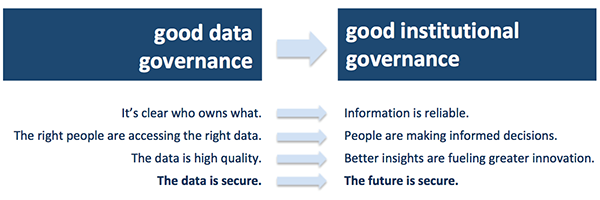No data governance plan? You’re risking one of your biggest assets.
Whether in retail, banking, or healthcare, today’s savviest business leaders count data among their top corporate assets—as valuable as products, equipment, facilities and employees—and they govern it as such. Higher education needs to adopt this approach as well.
Without a formal strategy for managing data, institutions are underutilising a key driver of efficiency, growth and innovation. “Data governance” is the framework for implementing that strategy.
In this series, we’ll help you get started with data governance by answering basic questions such as, “Where do we even begin?”, “Who and what are involved?” and “How do we sustain success?”
Starting in the right place
I work regularly with colleges and universities on setting up governance programmes, and I find that getting started—or more precisely, starting in the right place—is a common challenge. Here are three things that must happen first:
1. What is data governance
Understanding what data governance is and what it entails is crucial. These days, there’s no shortage of blogs, papers, training materials and conversations about data governance. There’s also no shortage of jargon, which can make it difficult to understand—and communicate to other stakeholders—exactly what the practice entails.
Most of the commonly used terms—whether governance, management or stewardship—all describe different aspects of the same goal: using data to better “govern” the institution.
In essence, data governance entails putting policies and systems in place to ensure that people have access to the data they need to make sound business decisions and to lead the institution toward success.

As you can see in the left column of the chart above, data governance has essentially four basic components:
- Data ownership: As with any area of life, if there’s not someone explicitly responsible for making something happen, chances are it won’t. Institutions can’t take that chance with data. Governance entails assigning the appropriate people across the institution with responsibility for managing, defining, interpreting and protecting the appropriate data.
- Data access: Setting rules about who can see what data—and then putting systems in place to enforce those rules—is one of the cornerstones of governance. Without rules, you risk non-compliance with privacy regulations, staff who won’t share data because of fear of misuse and people lacking the relevant information they need to do their jobs.
- Data quality: “Bad data” is what people most often associate with lack of governance. That’s because unreliable, missing or inaccurate data has the most visible impact on day-to-day operations. Governance entails creating formal processes for careful data entry, as well as defining, coding and interpreting data consistently across the institution.
- Data security: While there is obviously a large IT component to data security, the way in which average users handle data is just as critical. Governance entails establishing and enforcing rules about how data can be displayed, shared and discarded.
I’ll be going into greater detail on the people, policies and processes that go into each of these components in the next blog.
2. Establish a data governance council
Data governance is not an IT function. It’s an institutional mandate that requires cross-functional collaboration and stewardship.
One of the first things I help clients do is establish a formal data governance council. It should be composed of senior staff who oversee the operations and strategic direction of all areas of the business. That’s because complying with regulations, setting and enforcing policies about data usage and integration, and resolving conflicts all require cross-departmental collaboration at the highest level.
Successful data governance requires a massive culture shift and, often, implementation of new technology and workflows. Each council member must ensure buy-in and reinforce the legitimacy, importance and careful management of every major change.
3. Get leadership on board
Securing leadership endorsement is a must. You may establish a world-class data governance framework but it will only work if everyone complies. The rules can’t be perceived as optional. The president, leadership and board must signal to the entire institution: “We consider data one of our most valuable assets and this is how we manage it.”
As with any programme, you also need funding and resources. Without leadership support, it’s difficult to integrate activities into the institution’s annual budget and strategy or tie it to key performance indicators. Bottom line: engage leadership early and often.
Next steps
In the next blog, I’ll provide a checklist of elements that make up a good data governance strategy and framework.
Other blogs you might find useful
Are you drowning in data?
Breaking down the silos

